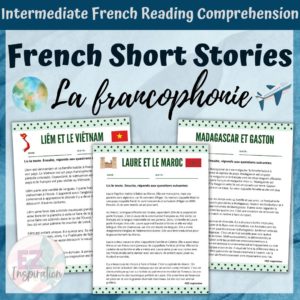
Reading in a different language can sound daunting to students. Many students feel overwhelmed when presented with a reading that appears to be too difficult and they feel that they don’t have the proper reading strategies to be successful.
However, with effective French reading strategies implemented in your classroom, you can increase your students’ confidence in reading and improve their French proficiency at the same time! Here are a few French reading strategies that I’ve used in my classroom to improve French reading comprehension among my students.
Part 1: Pre-Reading
When presented with a new text, it is important for students to activate their prior knowledge and scan the text ahead of time in order to get an idea about what will be discussed. Therefore, encourage students to :
Read the title and any headings
Study any images and make inferences
Briefly scan the text for familiar words
Identify any key vocabulary in the text that relates to its theme
Based on the images, titles, familiar words, and headings, you can encourage students to make predictions about the text. I usually give my students 5 minutes during the pre-reading phase and then we talk about their findings and predictions before reading the text aloud.

Part 2: Reading the Text
There are many ways that you can have students read a text. I try to incorporate a variety of methods when teaching French reading comprehension in my classroom so that there are many opportunities for students to reach the zone of proximal development and demonstrate an understanding of the text.
A. Read-Aloud
There are many benefits to reading a text aloud. Students will develop their listening skills and French pronunciation when reading aloud. Furthermore, reading aloud is also a great strategy for students who are auditory learners since they are able to hear the text and use their information processing skills to develop their vocabulary and French reading comprehension.
The first time I present a new text to my students, I will read it aloud as they follow along. I also encourage them to use a highlighter and highlight any words that are similar in English and French. These are referred to as les mots amis. For example :
Definition | Examples | |
Les mots amis | Cognates are words that are similar in French and English and have the same meaning |
|
After we finish reading the text for the first time, we will also discuss some of the mots amis that they found. I will add them to the board and this helps students to begin to understand the meaning of the text.
B. Reading the Text with a Partner
After the first read-aloud, I encourage students to read the text a second time but with a partner or small group. They are encouraged to read the text aloud, modeling pronunciation and intonation that they heard the first time it was read to them. They are to use a second highlighter during this read-aloud and highlight any words that they know in French. These are referred to as les mots familiers. For example :
Definition | Examples | |
Les mots familiers | Words that students have already learned in class |
|
Students are also encouraged to stop after each section of the text, brainstorm, and discuss what they read. Then, they can also discuss its significance based on their highlighted words.
By working together, students gain confidence in their reading abilities, discuss the text, and find its importance together. Many of my students LOVE group work and this allows for my extrovert and interpersonal students to succeed with their preferred learning style.
C. Reading Individually
The last step is to have students read individually. When reading individually, students can read at their own pace and break down the text further so that they can understand it. I encourage students to use a third highlighter this time when reading the text and will highlight all the words that they don’t know. These are referred to as les mots inconnus. For example :
Definition | Examples | |
Les mots inconnus | Words that the student doesn’t know |
|
After, students can read for meaning based on what they have highlighted. They are often surprised that they know more French than they thought! Students can further develop their French vocabulary by using an online French-English dictionary to identify any keywords that they don’t know. We often talk about these new words and I will write them on the board along with their English definition.
Part 3: Reflection

A. Creating a Summary
After students read a text, it is important for them to reflect upon what they learned. They can ask themselves simple questions in order to summarize general ideas that the text aims to portray. Here are some great questions that you can ask students to reflect upon after reading :
Who or what was the text about?
What is the message of the text? Why is its message important?
How does the author aim to get their message across? In your opinion, were they successful?
What do you think about the text?
Do you have any follow up questions?
Students can also make connections between what they’ve read and their prior knowledge of the topic. They can make further connections with their own life and the world around them. These are great observations to highlight together as a post-reading activity.
B. Metacognition
Metacognition is equally important to focus on after reading a text because it increases student motivation as students feel more in control of their learning. Students are held accountable for their learning process and it encourages them to be self-directed and flexible learners.
Students should be encouraged to describe strategies they found helpful before, during, and after reading the text. They should also reflect upon their comprehension performance and identify their areas of strength and steps that they can take to improve their French reading comprehension skills next time. This step can be done as an exit ticket, a journal reflection activity, a Google Form, a class discussion or a teacher-student interview.
Specific Resources Geared to French Reading Comprehension
French Reading Strategy Posters
This is a resource that I sell that encompasses different French Reading Strategy Posters that I hang up around my classroom at the beginning of a semester. These reading strategy posters help reinforce reading skills and are a great reference to students when reading in French.

Intermediate French Short Stories
If you are ever stuck for French reading comprehension texts that are geared toward Intermediate French learners, I do offer a few in my TPT store. Here are a couple of my favorites below :
Bonnes classes et bonne lecture !
Emily 🤍
P.S. Looking for some websites to enhance your students’ French reading comprehension? Check out this blog: 6 Phenomenal Websites for Enhancing French Reading Skills.





Pingback: 3 FREE Reading Comprehension Texts to Teach la Francophonie - EZ Inspiration